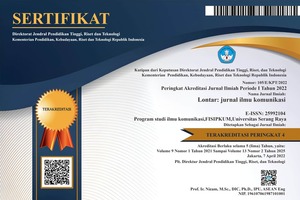Ogoh-Ogoh Kampung Bali Bekasi as a Symbol of Tolerance in Digital Communication and Tradition Preservation
DOI:
https://doi.org/10.30656/lontar.v13.i1.10308Keywords:
Ogoh-Ogoh, Kampung Bali Bekasi, Tolerance, Digital Communication, Tradition PreservationAbstract
The ogoh-ogoh tradition, which is closely associated with the Nyepi celebration, serves not only as a religious ritual but also as a symbol of tolerance and cultural interaction, particularly in Kampung Bali Bekasi. Although the majority of the residents in this area are not of Balinese descent, they actively participate in the ogoh-ogoh celebration, reflecting a process of acculturation and cultural openness. However, despite media coverage, the dissemination of information about this tradition remains limited and has yet to effectively reach a wider audience, especially the younger generation in the digital era. This study aims to analyze how the ogoh-ogoh tradition in Kampung Bali Bekasi serves as a symbol of tolerance and how digital communication contributes to its preservation. The research employs an ethnophenomenological approach, combining ethnographic communication studies and phenomenology. Data collection is conducted through participatory observation and in-depth interviews with community leaders and individuals involved in the ogoh-ogoh celebration. Documentation in the form of the film Bhuta Kala in Tolerance is also used as research data. The findings reveal that digital communication plays a crucial role in introducing and preserving the ogoh-ogoh tradition. Through platforms such as social media, communities can share cultural experiences and foster a broader cross-cultural understanding. Thus, this tradition not only serves as an educational medium but also strengthens social harmony in a multicultural environment.
References
Abror, M. (2020). Moderasi Beragama Dalam Bingkai Toleransi: Moderasi Beragama Dalam Bingkai Toleransi. RUSYDIAH: Jurnal Pemikiran Islam, 1(2), 143–155.
Adeng. (2014). Sejarah Sosial kota Bekasi. Patanjala, 6(3), 397–412.
Andzani, D., & Irwansyah. (2023). Dinamika Komunikasi Digital: Tren, Tantangan, dan Prospek Masa Depan. Syntax Idea, 5(11), 1964–1976.
Daryanto. (2011). Media Pembelajaran. Sarana Tutorial Nurani Sejahtera.
Gotama, P. S., Nabillah Azka, & Elyza Andressah. (2023). Perancangan Moda Uniseks Kontemporer Berbasis Akulturasi Budaya Jawa, Bali dan Lombok. Folio, 4(2), 18–28.
Hendro, F., Topan Setiawan, & Donna Setiawati. (2021). Mempertahankan Eksistensi Tradisi Tungguk Tembakau melalui Media Sosial. Jurnal Ilmu Komunikasi, 19(1), 78–92.
Mulyana, D. (2016). Metode Penelitian Kualitatif. Rosdakarya.
Poetra, Y. A., Fina Zahra, Nurul Fauziah, Sakha Putri Andhina, & Suci Rahmadhania. (2023). Pelatihan dan Pendampingan Pembuatan Media Audio Visual dalam Pelestarian Budaya dan Pengembangan Destinasi Wisata Kampung Bali Bekasi. ABDISOSHUM (Jurnal Pengabdian Masyarakat Bidang Sosial Dan Humaniora), 362(370), 2–3.
Rifa’i, M. (2017). Etnografi Komunikasi Ritual Tingkeban Neloni dan Mitoni (Studi Etnografi Komunikasi Bagi Etnis Jawa di Desa Sumbersuko Kecamatan Gempol kabupaten Pasuruan). ETTISAL Journal of Communication, 2(1), 27–40.
Rully. (2018). Efektifitas Iklan Negatif Di Media Sosial Dalam Politik Di Indonesia. Lontar : Jurnal Ilmu Komunikasi, 6(1), 69–79.
Setyaningrum, G. M. N., & Agus Cahyono. (2019). Strategi Adaptasi Masyarakat Non Hindu pada Pertunjukan Ogoh-Ogoh di Desa Linggoasri Kecamatan Kajen Kabupaten Pekalongan. Jurnal Seni Tari, 8(1), 83–94.
Supriyanto, J. (2022, March 1). Seru, Warga Kampung Bali Bekasi Gelar Karnaval Budaya Untuk Perkokoh Toleransi. Tribunnews.
Triwardani, R., & Christina Rochayati. (2014). Implementasi Kebijakan Desa Budaya Dalam Upayapelestarian Budaya Lokal. Reformasi, 4(2), 102–110.
Downloads
Published
Issue
Section
License
Copyright (c) 2025 LONTAR: Jurnal Ilmu Komunikasi

This work is licensed under a Creative Commons Attribution 4.0 International License.
By submitting an article to the journal, the author(s) agree to transfer the published article's copyright to the journal, which will act as the publisher. This means the journal will have the right to publish the article in various forms, including reprints. The journal will maintain the publishing rights to the published articles.
In line with the license, authors and third parties (readers, researchers, and others) are allowed to share and adapt the material. In addition, the material must be given appropriate credit, provided with a link to the license, and indicated if changes were made. If authors remix, transform, or build upon the material, authors must distribute their contributions under the same license as the original.





